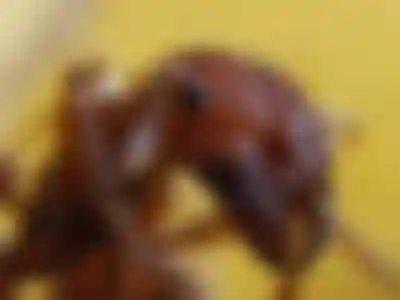All insects are part of earth .
What is an insect?
An insect is an arthropod that has distinctive characteristics such as three body segments, six jointed legs, one pair of antennae, one pair of compound eyes and an exoskeleton.
How many legs does an insect have?
All true members of class Insects have three pairs of jointed legs.
What is the life cycle of an insect?
Depending on the species, insects experience either complete or incomplete metamorphosis. The stages of complete metamorphosis are egg, larva, pupa and adult. The stages of incomplete metamorphosis are egg, nymph and adult. Insects generally have short life cycles that may last a few days or a few weeks.
Are spiders insects?
Spiders are not a part of the class Insects, but they are part of the larger group of arthropods. Some people incorrectly label this group as “anthropods,” but this is not quite right. Because they have four pairs of legs instead of three and only two distinct body segments, they belong to the class Arachnida.
Butterflies
Monarch Butterfly
Monarch Butterflies are known for their very distinct orange, black, and white coloring. These amazing creatures go through four stages in their life cycle: egg, larvae, pupa, and adult. While some adult monarch butterflies may only live for two to six weeks, during migration they can live for eight or nine months. When they migrate in the fall, a Monarch Butterfly will travel thousands of miles. And, while they fly on their own during the day, they will form large groups, known as roosts, at night.

Stages
• The four stages in the life cycle of a Monarch Butterfly are egg, larvae, pupa, and adult.
• Monarchs have black, orange, and white coloring which makes them easy to identify.
• During migration, Monarchs may fly thousands of miles.
• Losing their habitats is one of the biggest threats faced by Monarchs.
• Female Monarchs lay their eggs on milkweed plants.
Monarch Butterfly Scientific name
Monarch Butterflies are in the Insects Class and belong to the Nymphalida Family. Their scientific name is Danaus plexippus. Danaus refers to a genus of butterflies and plexippus refers to the specific Monarch Butterfly species.
Purple Emperor Butterfly

Purple Emperor Species, Types, and Scientific Name
The scientific name of the Purple Emperor is Apatura iris. Apatura is probably from the Greek word Apaturia, which means “the deceitful one” and was used to describe several goddesses. The word probably refers to the deceptive nature of the male Purple Emperor’s wings, which only show their iridescence under the right conditions. The other half of the butterfly’s scientific name, Iris, refers to the Greek goddess of the rainbow.
Ant
The ant is a small-sized invertebrate that is found all around the world, with the exception of the polar regions including the Arctic Circle and Antarctica. As with many other species of insect, there are numerous ant species inhabiting many different environments all around the world.
Incredible Ant Facts
There is a species of ants found nowhere else on Earth except for between 63rd and 76th streets in New York. Its name: ManhattAnt.
More than 300 spider species have evolved to disguise themselves as ants as a predatory technique.
There is a single “super ant colony” that stretches 3,700 miles along the Mediterranean coast.
Ant Species: The Types of Ants
There are more than 12,000 recognized species of ant worldwide, but there are estimated to be nearly 14,000 in total. Ants are thought to have developed from wasp like creatures 100 million years ago after blooming flowers appeared on Earth.

Beetle
The beetle has the largest number of sub-species out of all the insects, with 40% of all recognised insects being classed as beetles. There are more than 350,000 different species of noted beetle, however, scientists estimate the real number is between 4 million and 8 million beetle species.
As with other species of insects, the body of the beetle is comprised of three sections all coated in the hard outer shell, which are the head of the beetle, the thorax of the beetle and the abdomen of the beetle. Beetles also have antennae which are used to understand the surroundings of the beetle and are made of about 10 different sections.
Beetles are believed to play a vital role in whichever ecosystem they are inhabiting mainly as they consume the debris from plants and animals including fallen petals and animal dung. All animals that ingest decomposing material are working wonders for the soil as they are consuming a large proportion of the compounds that would otherwise be absorbed into the soil, such as carbon dioxide and nitrogen.
The beetle is an omnivorous animals and feeds on whatever it can find but generally plants and fungi and the debris from both plants and animals. Some bigger species of beetle have been known to eat small birds and even small species of mammal. Other species of beetle feed of the dust from wood and therefore enjoy burrowing themselves into trees.
Due to their small size and wide, diverse range, beetles are prey to numerous species of animal from other insects to reptiles, birds, fish and mammals. The exact predators of the beetle however are largely dependent on the size and species of the beetle and the area in which the beetle inhabits.
Recently, the Asian long-horned beetle has been found in number of North American states with the beetle having quickly gained a name for itself as an agricultural pest. The Asian long-horned beetle is a type of bark boring beetle which means that they dig themselves into wood.

Camel Spider
The camel spider lives in the Middle East, Mexico, and the southwestern area of the United States. They live in dry climates like deserts and scrublands. This animal is a carnivore that eats rodents, small birds, insects, and lizards. The bite of this creature is very painful to humans.
5 Fascinating Camel Spider Facts
Camel spiders are solitary animals, except for mating.
Females lay from 50 to 200 eggs and remain in the burrow with them until they hatch unless she didn’t store enough fat and starves.
These animals are nocturnal hunters and avoid going out in the day because of the intense heat.
They can grow to be six inches long. Not surprisingly, the ‘giant camel spider’ is one of the biggest.
Camel spiders are not venomous, but their bite is very painful..
Camel Spider Scientific Name
The camel spider belongs to the Solpugidae family and the class Arachnida. This animal goes by a few other names including wind scorpion, sun spider, and the Egyptian Giant solpugid. Solpugid is the Latin word for ‘sun spider.’
This creature got its name based on the myth
that it eats the insides of a camel’s stomach. This is not true. But the name has stuck with it despite the busted myth, making the name camel spider a bit misleading.
Camel Spider Appearance and Behavior
A camel spider is tan and dark brown in color with small hairs on its body. The fine hairs on the body of a camel spider help to insulate it from the desert heat. The coloration of a camel spider helps it to blend into the dry, hot environment around them. This can help it stay clear of predators.
While it has eight legs, some people mistakenly think it has ten because camel spiders have two long pedipalps (a second pair of appendages) near their mouths. They use these to find and pull in their prey.
The size of this spider ranges from 3 to 6 inches long. It weighs about two ounces. If you put three golf tees on the ground end to end you would be looking at the length of a six-inch camel spider. Hold a tennis ball in your hand and you are holding something that’s about the same weight as a two-ounce camel spider. The camel spider is one of the biggest spiders in the world.
Camel spiders can move quickly through their desert or scrubland habitat. The fastest they can go is 10 mph – which, while not slow, is only about one fifth as fast as a rabbit. The next time you hop in the car, watch the speedometer as it moves up to 10 mph, this will give you a solid idea of how fast this animal moves!

Asian Giant Hornet
The Asian giant hornet has reached fame thanks to its nickname online, the “murder hornet.” While the species stings can be quite painful, its estimated the hornets kill less than 40 people a year in countries across Asia.
For perspective, 89 people in the U.S. died in 2017 from native hornets, wasps and bees, per the CDC.
The hornets are native to the Asian seaboard, stretching from Russia’s Far East to the tropics. However, in 2019 and 2020 sightings of these “murder hornets” began appearing in the Pacific Northwest, raising fears they could decimate local bee populations due to their signature decapitation of large honey bee populations with their large mandibles. The hornets then and carry the thorax from their victims to feed their young.
Because a single murder hornet can kill up to 40 honey bees a minute, it only takes a few hornets to completely decimate an entire colony of honey bees in short order.
On October 23rd the first U.S. “murder hornet” nest was found near Blaine, Washington, further raising fears the species could become invasive and threaten bee populations that are integral to pollinating many crops.
Incredible Asian Giant Hornet Facts!
Murder hornets: The Asian giant hornet has attracted significant attention online thanks to its nickname of the “murder hornet.” Why the dramatic nickname? For one, the species can grow quite large, with queens reaching more than 2 inches in length.
Voracious Predators: In addition to their large size, giant hornets received their “murder hornet” nickname from their voracious predatory habits. A single Asian giant hornet can kill more than 40 bees per minute by rapidly using its large mandibles to decapitate beer after bee!
But Asian bees have evolved to face this threat! With Asian bees continually facing off against “murder hornets,” they’ve evolved a unique adaptation to fight hornets invading their nest. Bees swarm around the hornets and vibrate their flight muscles, raising their temperature to 117 degrees. Bees can withstand a temperature of 118 degrees, while hornets can only support internal temperatures of 115 degrees. They use this very slight difference to effectively “cook” murder hornets alive!
Asian Giant Hornet Classification and Evolution
The Asian giant hornet is the largest species of hornet in the world with some queens reaching more than 5cm in length. They are found throughout Eastern Asia, particularly in Japan where they are commonly known as the Giant Sparrow Bee. It is not to be confused with the more placid Asian hornet which arrived in France in 2005 and, although similar in appearance to the Asian giant hornet, the Asian Hornet is thought to be no more dangerous than the European hornet. The Asian giant hornet was first classified in 1852 by a British entomologist called Frederick Smith, who worked in the zoology department of the British Museum. He later became the president of the Entomological Society of London from 1862 – 1863.
Asian Giant Hornet Anatomy and Appearance
This wasp species is larger than any others with average Asian giant hornets growing to between 2.7cm and 4.5cm in length, with a wingspan of around 7cm. The queens can grow to 5.5cm but are similar in appearance to the worker hornets with an orange head, black mandibles and a black and golden body. The Asian giant hornet has two sets of eyes, one compound and one ocelli, both of which are brown in color along with their legs. Unlike other species of wasp, and indeed bees, the stinger of the Asian giant hornet is not barbed and therefore remains attached to its body once used. This means that Asian Giant Hornets are able to sting their victims repeatedly, injecting a complex venom that is known to contain eight different chemicals.
Asian Giant Hornet FAQs (Frequently Asked Questions)
Are Asian Giant Hornets herbivores, carnivores, or omnivores?
Asian Giant Hornets are Carnivores, meaning they eat other animals.
What Kingdom do Asian Giant Hornets belong to?
Asian Giant Hornets belong to the Kingdom Animalia.
What phylum to Asian Giant Hornets belong to?
Asian Giant Hornets belong to the phylum Arthropoda.
What family do Asian Giant Hornets belong to?
Asian Giant Hornets belong to the family Vespidae.
What order do Asian Giant Hornets belong to?
Asian Giant Hornets belong to the order Hymenoptera.
What type of covering do Asian Giant Hornets have?
Asian Giant Hornets are covered in Shells.
What genus do Asian Giant Hornets belong to?
Asian Giant Hornets belong to the genus Vespa.
Where do Asian Giant Hornets live?
Asian Giant Hornets live in eastern Asia.
In what type of habitat do Asian Giant Hornets live?
Asian Giant Hornets live in dense woodlands.
What are some predators of Asian Giant Hornets?
Predators of Asian Giant Hornets include humans.
What are some distinguishing features of Asian Giant Hornets?
Asian Giant Hornets have wide black and orange bodies and large mandibles.
What is an interesting fact about Asian Giant Hornets?
Asian Giant Hornets are the largest wasp in the world!
What is the scientific name for the Asian Giant Hornet?
The scientific name for the Asian Giant Hornet is Vespa mandarinia.
What is the lifespan of an Asian Giant Hornet?
Asian Giant Hornets can live for 3 to 5 months.
How many species of Asian Giant Hornet are there?
There is 1 species of Asian Giant Hornet.
What is the biggest threat to the Asian Giant Hornet?
The biggest threat to the Asian Giant Hornet is habitat loss.
What is another name for the Asian Giant Hornet?
The Asian Giant Hornet is also called the giant sparrow bee.
How many Asian Giant Hornets are left in the world?
The population size of the Asian Giant Hornet is unknown.
How do Asian Giant Hornets have babies?
Asian Giant Hornets lay eggs.





Write about your real life stories, robo Interested in it and make your Content original. And also Join noise.cash that's the part of readcash and pay you for short posts or microblogging 🎸